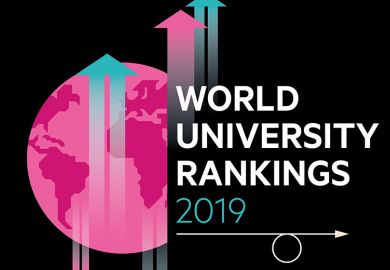Browse the full results of the World University Rankings 2019
Internationalisation is a means to an end for the star performers in the international outlook pillar of the Times Higher Education World University Rankings; it is a way to attract the best students and staff from all over the world, they say.
The top universities in this pillar represent a spectrum of institutions throughout Europe, Asia and the Middle East, with the City University of Hong Kong and Qatar University tied for the top spot. However, the main winners in this year’s international outlook pillar are Switzerland and Hong Kong. The two territories have three and two universities, respectively, in the top 10, namely École Polytechnique Fédérale de Lausanne (joint seventh), the University of Geneva (ninth), and ETH Zurich (10th) in Switzerland, and City University of Hong Kong and the University of Hong Kong (joint third) in the Chinese region.
Both places, although they are separated by almost 10,000km (6,213 miles), see themselves as hubs of internationalisation and cultural exchange.
Part of Switzerland’s success as a country in general has been its openness to foreigners, who make up a high percentage of the population, says Olivier Kuttel, head of international affairs at EPFL.
The same holds true for the higher education sector, he says. EPFL is based in the French-speaking part of Switzerland, which has about 1 million citizens.
“You cannot build a university out of 1 million people. If you want to be a good university, you have to be international,” he says. Nearly two-thirds of the institution’s professors and 75 per cent of its doctoral candidates are from abroad. “It is not a goal, per se: it is a consequence of wanting to attract the best people,” he adds.
It is the same for the University of Luxembourg, which ties in third place with the University of Hong Kong. Internationalisation has been part of its ethos since it was established in 2003, says Professor Tonie van Dam, vice-rector for international relations, doctoral education and gender relations at Luxembourg. “We do not view internationalisation as a goal in itself, but more as a means by which we can achieve excellence in research and education,” she says.
According to its mission statement, the University of Hong Kong believes that the continuing globalisation of higher education is inevitable in an “ever-interconnected and interdependent mobile world”. The university claims that it has the qualities and attributes required by the international academic community, while functioning as a gateway to mainland China.
Search our database of more than 3,000 global university jobs
THE determines the top universities in this pillar based on their proportions of international students and international staff, as well as their international research collaborations. The seeds of success are similar for most highly ranked universities.
A major factor is multilingualism. The University of Luxembourg – based in the tiny, landlocked eponymous country, which is surrounded by France, Germany and Belgium – offers study programmes in English, French or German. Some of the university’s degrees are even trilingual, says van Dam. EPFL’s undergraduate degrees are mostly taught in French; however, from master’s level, English dominates “with the aim of attracting foreign students”, says Kuttel.
Qatar University has an extensive range of support programmes for foreign students and has a centre dedicated to teaching Arabic to foreign students. Its student body comprises students from 85 countries and the university offers scholarships to about 400 recipients each academic year in order to attract the best candidates. The institution has numerous student support programmes, one of which even includes airport pick-ups for newly arrived foreign students.

The top universities in the international outlook pillar offer international exchange as part of their academic experience, too. The University of Hong Kong has more than 340 exchange partners across the world and offers dual-degree programmes with other universities. “We are moving towards providing every undergraduate student with one learning opportunity in mainland China plus one experience elsewhere,” says vice-president and pro-vice-chancellor (global) W. John Kao. The institution currently has almost 10,000 international students.
“Looking ahead, we will continue to extend opportunities for cross-cultural encounters, deepen multicultural components of campus life, as well as increase opportunities for students to gain learning experiences in mainland China and overseas,” he says.
Like the University of Hong Kong, the City University of Hong Kong also offers a link to mainland China because of its location. Just north of the University of Hong Kong, CityU has specific programmes geared towards broadening students’ international horizons; its “CityU Go Global” initiative includes opportunities for overseas exchange, internships, service learning, summer programmes and joint degrees.
In Europe, it is compulsory for all bachelor’s students at the University of Luxembourg to spend a semester abroad, says van Dam. The university has more than 100 cooperation agreements with partner institutions in Europe and elsewhere in the world, and offers many exchange opportunities for master’s and doctoral candidates.
EPFL tries to not only attract the best students and staff from other countries, but also encourage them to stay. In 2000, it introduced a tenure-track system. There are not enough “landing spots” on the continent for European researchers returning from the US or UK, says Kuttel. Their tenure-track programme offers postdoctoral researchers a six-year contract as an assistant professor, to allow them to showcase their abilities.
“This tenure-track system is common in the US, but not so common in Europe. This is one of our ways to attract brilliant young people,” he says. The tenure-track programme allows them complete freedom, with their own research agenda and budget.
Attracting professors is more difficult, because it is not just about the salary, he says. It is about the package, which includes salary, lab space and base funding for their research group.
However, financial incentives are not enough to attract the best. Reputation is a magnet that draws students, staff and international collaborators to a university, say many of the top-performing institutions.
Australian National University, at joint 29th place, says that its staff and students draw on the best research from across the world “and that is what continues to attract the best people to join us”. The institution has partnerships with more than 400 universities around the world and about 36 per cent of its student body hail from another country. “We seek to provide all our students with a truly global learning experience,” says a university spokeswoman.
This global experience and an ethos of internationalisation are what ultimately draw foreign students and staff to universities in other countries.
“The success of a university is the professors and the good students,” says EPFL’s Kuttel. “This really is key: bring the best people to the university.”
International outlook
|
Rank in pillar |
Position in World University Rankings |
Institution |
Country/region |
Pillar score |
|
=1 |
=110 |
Hong Kong |
99.8 |
|
|
=1 |
401–500 |
Qatar |
99.8 |
|
|
=3 |
36 |
Hong Kong |
99.7 |
|
|
=3 |
201–250 |
Luxembourg |
99.7 |
|
|
5 |
351–400 |
Macao |
99.3 |
|
|
6 |
801–1,000 |
United Arab Emirates |
99.1 |
|
|
=7 |
301–350 |
Saudi Arabia |
98.7 |
|
|
=7 |
35 |
Switzerland |
98.7 |
|
|
9 |
=135 |
Switzerland |
98.5 |
|
|
10 |
11 |
Switzerland |
98.2 |
|
|
11 |
351–400 |
Austria |
97.4 |
|
|
12 |
9 |
United Kingdom |
97.1 |
|
|
13 |
=128 |
Netherlands |
97.0 |
|
|
14 |
251–300 |
United Kingdom |
96.6 |
|
|
15 |
301–350 |
United Arab Emirates |
96.4 |
|
|
=16 |
1 |
United Kingdom |
96.3 |
|
|
=16 |
201–250 |
United Kingdom |
96.3 |
|
|
=16 |
165 |
United Kingdom |
96.3 |
|
|
=16 |
401–500 |
Switzerland |
96.3 |
|
|
=20 |
103 |
Switzerland |
96.1 |
|
|
=20 |
130 |
United Kingdom |
96.1 |
|
|
22 |
301–350 |
New Zealand |
96.0 |
|
|
23 |
801–1,000 |
United Arab Emirates |
95.9 |
|
|
24 |
14 |
UCL |
United Kingdom |
95.8 |
|
25 |
23 |
Singapore |
95.5 |
|
|
=26 |
51 |
Singapore |
95.4 |
|
|
=26 |
196 |
University of Technology, Sydney |
Australia |
95.4 |
|
28 |
38 |
United Kingdom |
95.3 |
|
|
=29 |
158 |
United Kingdom |
95.0 |
|
|
=29 |
49 |
Australia |
95.0 |
|
|
31 |
301–350 |
Australia |
94.9 |
|
|
32 |
401–500 |
Brunel University London |
United Kingdom |
94.8 |
|
33 |
351–400 |
United Kingdom |
94.5 |
|
|
34 |
=143 |
Austria |
94.4 |
|
|
=35 |
2 |
United Kingdom |
94.3 |
|
|
=35 |
351–400 |
United Arab Emirates |
94.3 |
|
|
37 |
301–350 |
United Kingdom |
94.1 |
|
|
38 |
108 |
École Polytechnique |
France |
94.0 |
|
=39 |
37 |
Canada |
93.9 |
|
|
=39 |
118 |
United Kingdom |
93.9 |
|
|
=41 |
29 |
United Kingdom |
93.3 |
|
|
=41 |
=146 |
United Kingdom |
93.3 |
|
|
=41 |
120 |
Republic of Ireland |
93.3 |
|
|
=41 |
=79 |
United Kingdom |
93.3 |
|
|
=45 |
351–400 |
United Kingdom |
93.2 |
|
|
=45 |
251–300 |
United Kingdom |
93.2 |
|
|
=47 |
501–600 |
New Zealand |
93.1 |
|
|
=47 |
=32 |
Australia |
93.1 |
|
|
=47 |
134 |
University of Western Australia |
Australia |
93.1 |
|
=50 |
201–250 |
Saudi Arabia |
92.9 |
|
|
=50 |
251–300 |
United Kingdom |
92.9 |
|
|
=50 |
201–250 |
Australia |
92.9 |
POSTSCRIPT:
Print headline: Walk this way
Register to continue
Why register?
- Registration is free and only takes a moment
- Once registered, you can read 3 articles a month
- Sign up for our newsletter
Subscribe
Or subscribe for unlimited access to:
- Unlimited access to news, views, insights & reviews
- Digital editions
- Digital access to THE’s university and college rankings analysis
Already registered or a current subscriber? Login

















